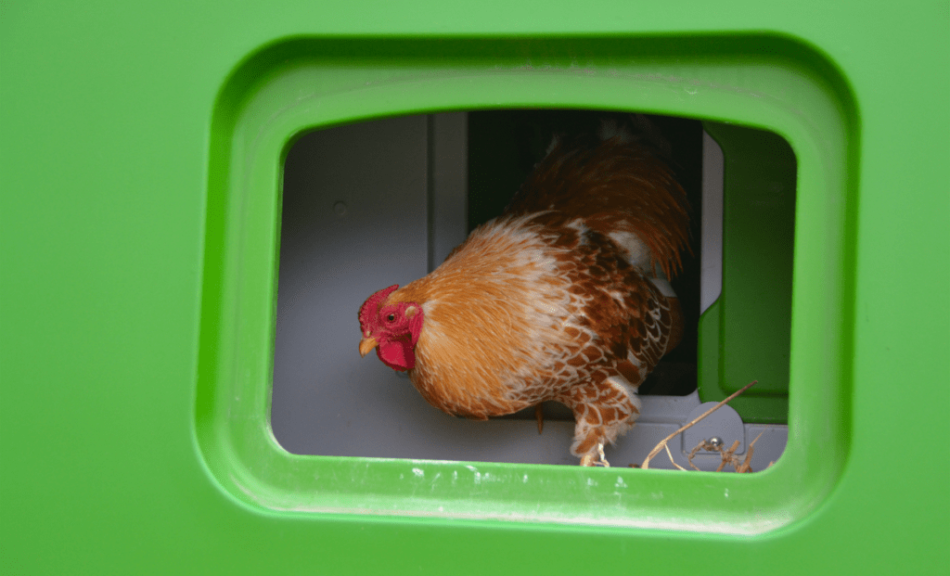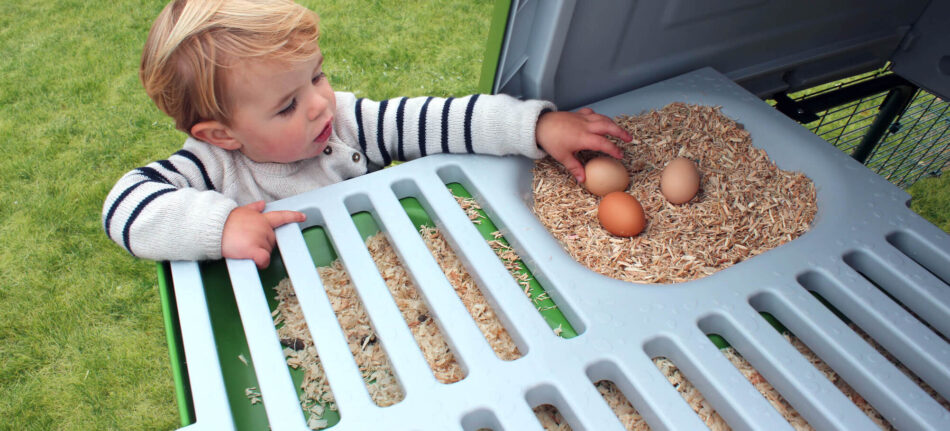Chicken nesting box guide
Chicken nesting boxes come in so many shapes, sizes, and materials that it can be hard to decide which type will be best for your flock or coop. Hens need sturdy, safe, and secluded areas to lay their eggs comfortably, and choosing the right nesting box will help achieve this setting. We’ve created the ultimate chicken nesting box guide so that you can maximize your flock’s egg-laying experience while reducing your workload.
Table of Contents
What are chicken nesting boxes?
Chickens will instinctively lay their eggs in what they perceive is the safest place to make their nest. Multiple hens will use the same nesting area, trusting the judgement of the first hen who chose the spot. The majority of hens feel most at ease in an elevated station to lay their eggs, but will also seek a dark and secluded area at ground level.
Providing egg-laying hens a comfortable nesting box is an essential role in chicken-keeping. Without a nesting box, hens will become nervous as they prepare for the arrival of an egg, and various negative behaviours or outcomes can sprout as a result of not having a safe nesting area. These include:
- Hens eating their eggs, because they don’t feel like their nest is safe
- Random eggs littered around the run can attract rodents or predators, and encourage flock egg-eating
- Stressed hens with missing feathers, poor appetite, or dull appearance
- A decrease in egg production
Young hens can start laying eggs as early as 16 weeks old, so it’s important that your chicken coop has appropriate nesting boxes from the time you move your pullets in.
Chicken coop nesting box problems
If your flock’s nesting area is not in the right place, or is unable to maintain ideal conditions, your hens will abandon using them. Here are some common problems with nesting boxes.
Placement
One of the main reasons a chicken is not using their nesting box is because of poor placement. Nesting boxes are best utilized when they are part of the coop and not out in the run. They should be in a designated, secluded area where hens neither sleep nor frequent for any other reason than to lay their eggs.
Accessibility
Another key design feature of a nesting box is accessibility – for both you and your chickens. Hens should be able to easily access nesting areas. Nesting boxes should be between 1-3 feet off of the ground, and have a comfortable ramp or ladder leading up to them. The path to the nesting boxes should be kept free of obstructions, and not in an awkward position of the run that has you bending down or squeezing in to collect eggs. If hens can’t easily access their nesting boxes, you’ll find your chicken hiding eggs around the run. It might sound like fun to have an Easter egg hunt every day, but this method of nesting is stressful for hens and can easily lead to unwanted long-term behaviours like egg eating or refusal to use even an accommodating nesting box.
Comfort level
Chickens not laying eggs may be the direct result of them not feeling comfortable in their nesting box. If the nesting box is well placed, and can be accessed easily, but your hens are still not laying their eggs in it, it’s time to consider the comfort of the nesting box. For optimum comfort, make sure your hens’ nesting box:
- Isn’t in a high-traffic area
- Doesn’t receive direct sunlight
- Has low noise levels
- Is well ventilated
- Maintains its cleanliness
Chickens shouldn’t sleep in their nesting boxes, so bedding doesn’t need to be changed as frequently as the rest of the coop. Depending on your bedding of choice and the number of hens you have, the nesting box can be refreshed every 2-4 weeks.
Inappropriate bedding
There are many different choices for bedding in a nesting box, but hens feel best making a nest in loose, fluffy bedding like shavings or straw. Avoid using faux turf pads, kennel liners, or rubber mats in nesting boxes, as these feel unnatural and don’t offer much padding for the eggs being laid. Aspen fibre nesting pads can be fluffed up to make an acceptable nest, and are a good alternative option for chicken keepers wanting to use removable substrate in their nesting boxes.
How many nesting boxes are needed per chicken?
Four hens can happily share one nesting box, but five may become a crowd. Some larger flocks share one nesting box just fine, but it’s largely dependent on your hens’ personalities and laying frequency between chicken breeds. And, any nesting areas need to be large enough for your hens to stand up, turn around, and avoid crushing eggs, while being small enough to feel cosy and secure.
While the term “nesting box” implies a square shape, you can think outside the box when it comes to nesting areas. Oblong nesting areas are a great alternative to traditional boxes, as they give hens more space to fluff their bedding and settle themselves into whatever position is most comfortable for them. Omlet’s chicken coops come in a variety of sizes, all with integrated nesting areas to accommodate any size flock or hen. The Eglu Cube in particular is a favourite among flock-keepers for its elevated structure, dedicated nesting-area door, and sliding partition between the roosting and laying areas. The spacious nesting area allows for 2 hens to lay at time when schedules overlap, and gives your hens options of where to lay their eggs within the space.
There are many different types of chicken nesting boxes. Some are DIY projects, while others are commercially made from metal or other materials. Some are anchored to the coop, while others may pull out or be removed for cleaning. There are pros and cons to each type of construction, but as most chicken keepers would agree, integrated nesting boxes that are easy to access and clean are the best type of nesting areas.
Wooden nesting boxes
Wooden nesting boxes get the job done, but are notorious for harbouring bacteria, mildew, and mites. Because wood is porous, wooden nesting boxes are difficult to keep clean or sanitize thoroughly. They’re relatively inexpensive to make, but can easily be made too heavy to mount to a chicken coop. Because of this, they often require their own support like legs or even a table to be mounted to – something that most backyard flock raisers don’t have room for. Those opting to buy rather than make a wooden nesting box should note that they are usually made from flimsy, cheap materials that will break down quickly.
Pros:
- Inexpensive to construct or obtain
Cons:
- Absorb moisture and bacteria, and house mites
- Heavy, cumbersome, and impractical for most flock raisers
- Commercially made versions are cheap and flimsy
Metal nesting boxes
When thinking about nesting boxes, most people conjure up the image of traditional chicken nesting boxes made of metal. These structures can have anywhere from 1-10+ “holes” that lead into a nesting box. They stack in rows, which takes up less space, but may become too tall for some hens to reach the top row. Metal outlasts wood, but still succumbs to the elements – especially in hot, humid areas. Rust is common in metal nesting boxes, and the boxes themselves can become very hot and stuffy.
Pros:
- Longer lasting than wood
- Easier to clean than wood
Cons:
- Rusts over time
- Can easily become too hot for hens
- Expensive
DIY nesting boxes
This inexpensive option can get the job done, but should only be used for supplemental or temporary nesting areas. DIY nesting boxes can be made from repurposed milk crates, storage bins, or 5-gallon buckets turned on their side. These materials are difficult to place and anchor in ideal locations. They also require alterations to make them safe, which may cost more than the project is worth.
Pros:
- Inexpensive
- Readily available
Cons:
- Flimsy
- Uncomfortable
- Potentially dangerous without modifications
Plastic nesting boxes
The best material for nesting boxes is plastic. This non-porous material is easy to clean and outlasts other types of nesting boxes. It wards also off parasites and prevents moisture buildup. While plastic nesting boxes might not be as popular as other types, their long-term value makes them well worth it.
Pros:
- Long-lasting
- Easy to clean
- Free of parasites
Cons:
- Not as readily available as other options
- More expensive to obtain
The best of both worlds: integrated plastic nesting boxes
Thankfully, there’s an all-in-one option with modern hen houses. Omlet’s plastic chicken coops all have integrated nesting boxes and roosting bars for a convenient and comfortable interior. The nesting area is part of the removable tray, which can be pressure washed and refreshed in minutes.
Creating the ideal chicken nesting box with Omlet
With Omlet, making and maintaining the ideal nesting area is fun and easy. Your hens will feel safe and secure in the elevated and spacious Eglu Cube and its integrated nesting area. This large chicken coop even has a dedicated nesting box door to collect eggs without disturbing the rest of the coop.
With happy hens, you’ll have lots of eggs to gather, giving your family a fresh egg supply. Not only will a clean and tidy nesting box make your hens feel comfortable, but you’ll also have the unique satisfaction that comes from collecting a still-warm egg from the nesting area.
Chicken care with Omlet
Keeping your hens happy isn’t just limited to providing the ideal nesting area. At Omlet, we have chicken-keeping essentials for every area of flock raising. From enriching chicken toys and accessories to technology like automatic chicken coop doors that make your schedule simpler and your flock safer, you can have confidence that your chickens are happy in their coop.
This entry was posted in Chickens



One reply on “Chicken nesting box guide”
very educative information for me is beginning. I need more information about the local breed. Thank you.